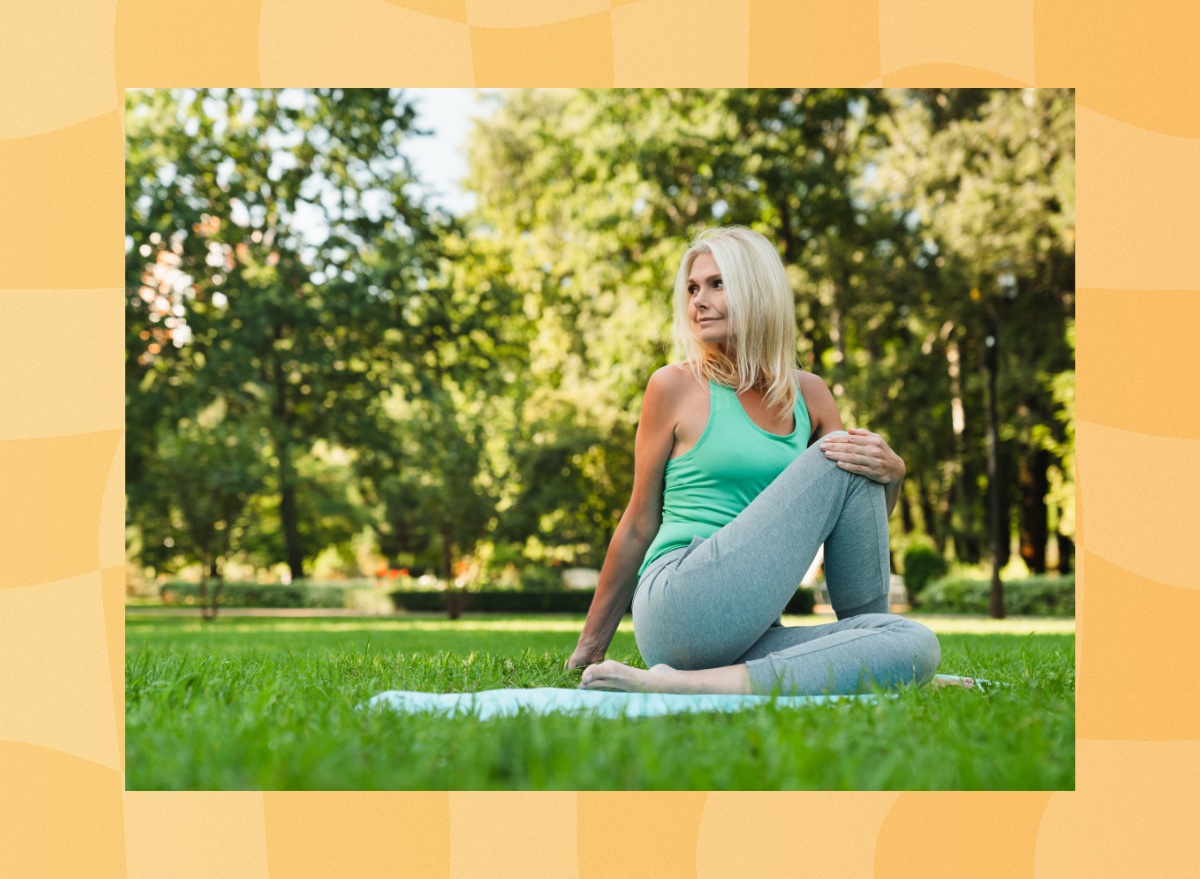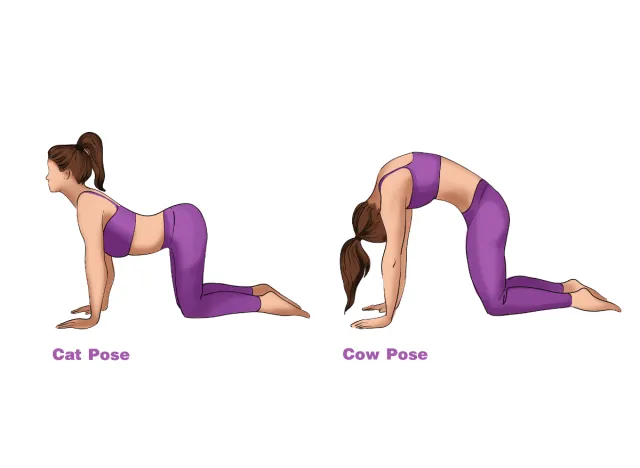10 Floor Exercises a 60-Year-Old Instructor Does To Stay Fit & Mobile

Self-care and exercise are always key when it comes to leading a healthy lifestyle. As you age, it's especially important to work out, as it improves your balance and strength and decreases your chances of suffering from stroke, heart disease, and so much more. We spoke with 60-year-old Bonnie Strati, master flexologist for StretchLab, who shares 10 of the best floor exercises for mobility and improved fitness.
"Being a flexologist is a very physically demanding role that requires us to be in top shape—to not only be a role model for our clients, but to have longevity in our lives to continue to participate in all the activities that we love to do," Strati tells us. "Here are movements I do as a routine and/or as individual movements when I need to release tension in any area of my body."
The below exercises should be performed slowly. Be mindful of any sensations you feel while doing them. For instance, beware if a certain exercise doesn't feel as though you're moving easily or connecting with your breathing.
So grab your mat, and read on to learn the best floor exercises for mobility and improved fitness. And when you're finished, don't miss the 6 Best Pilates Exercises to Improve Your Balance & Coordination.
Ankle exercises:
First up on the best floor exercises for mobility, it's time to focus on your ankles. Strati explains, "One of the main reasons for maintaining ankle mobility and range of motion is to aid in the prevention of injuries in the knee and hip joint. As a flexologist, I spend a lot of time in a lunge position on the bench so these movements prepare my feet, ankles, and calves for a day at work."
1. Ankle Circles
Lie flat on your back with bent knees and lifted. Hold your legs gently behind both knees. Move your ankles in a circular clockwise motion five times before reversing counterclockwise. "Do this movement slowly, articulating the movement and noticing any restrictions in any direction," shares Strati.
2. Ankle Flexion
Move right into this next movement, the ankle flexion, from the previous exercise. Begin by dorsiflexing your foot, drawing your toes in toward your shins. At this point, your calf muscles should feel lengthened and your shin muscles engaged. "Plantar flex your foot by pointing your foot away from your shins. (You will feel the muscles in your shin lengthen and calf muscle—gastrocnemius—activate). Your breath should be smooth and even during this movement," Strati instructs. Do this exercise five times for each ankle.
Lower-back exercise:
To prevent pain in your lower back and issues with your posture, it's important to preserve mobility in your lower spine. Strati tells us, "Releasing tension in the lower back prepares for movements of bending and reaching that are performed throughout the day."
3. Tilt and Rock
Begin by lying on your back with your knees bent and both feet on the ground. Your feet should be kept close to your glutes or right below your knees. "With your hands on your hip bones, breathe in gently and tilt your hip bones toward your thighs creating space under your lower back. Exhale, [and] press the back of your waist to the floor as you draw your belly button to your spine. Do your best not to contract your abdominal muscles or your glutes—this is a movement to release the small muscles of the lower back." Do this exercise for eight reps or more as needed.
Hip exercise:
To avoid injuries in your kinetic chain and improve your overall athletic performance and lifestyle, it's crucial to maintain hip mobility and a good range of motion.
4. Drop Knee Twist
Start by lying flat on your back with bent knees and your feet placed wider than hip-width apart. Keep your arms lengthened to form a "T" position on the floor with your palms upward.
"Exhale—gently let the knees fall to the right while the chin rocks to the left collarbone," Strati instructs. "Inhale, lift the knees back through the center (letting the back of the waist connect to the floor), and exhale as you let the knees fall to the left and the chin toward your right collarbone." Perform the exercise for five to eight reps, being mindful of which side has more tension.
Arm and wrist exercises:
Ensure your hands stay in good health and you can continue to perform strength exercises and daily tasks by preserving your wrist mobility.
5. Arm Circles
Begin with your arms extended toward the sky. Move your arms in a circular motion clockwise five times, and then move them counterclockwise another five times. Keep the movement slow.
6. Wrist Flexion and Extension
Fold your hand toward your forearm as you flex your wrist. "You will also feel your forearms activating and lengthening through this movement—starting to prep them," Strati explains. Complete five reps on each hand.
Spine exercise:
Taking care of your spine mobility will help preserve your posture and decrease any back pain you may have.
7. Cat / Cow

Assume all fours on your hands and knees, ensuring your hips are over your knees and your shoulders are over your wrists. "Exhale, and draw the belly button toward your spine as your tailbone tucks toward the floor creating an angry cat shape with your spine," Strati says. "Slowly move from the base of your spine (tailbone) all the way to the top of spine, letting your head be the last thing to release."
Knee exercise:
This exercise will ensure easier knee mobility and better athletic performance.
8. Kneeling Lunge / Ankle Mobility
Assume a half-kneeling lunge position with your right foot forward and your back knee on the floor. This exercise can also be performed in a standing position, keeping your right foot on a secure surface like a chair.
"Keeping [your] front heel firmly on the ground, inhale, [and] slowly lunge hips forward to allow the right knee to go past the toes, stopping at the point of restriction," instructs Strati. "Exhale, press [your] heel into [the] ground or chair, and return to [the] starting position." Perform this exercise 10 times, aiming to increase your range of motion each time without forcing it.
Shoulder exercise:
By protracting and retracting, you will improve muscle engagement in your upper extremities. This allows for an enhanced range of motion and overall function.
9. Protraction / Retraction
Begin lying on a foam roller on the floor with your knees bent. Lengthen your arms toward the ceiling, ensuring they're shoulder-distance apart. Your palms should face each other.
"Inhale, [and] reach your fingers as if you are going to touch the ceiling, feeling the muscles in the back of your shoulders expanding," says Strati. "Exhale, [and] retract the arm bones back into the socket of the shoulder. If you are on the
foam roller, you may feel the shoulders wrapping around the roller." Perform both movements for 10 reps.
Neck exercise:
Neck mobility is essential when it comes to eliminating stress from the spine. It also helps protect your brain.
10. Isometrics w/PNF
Start in a comfortable seated position on the floor, keeping your spine elongated. "This is one of my favorite movements to increase the range of motion in your neck and incorporates the PNF technique we use at StretchLab," says Strati.
"First, make sure your head is directly over your shoulders [and your] ears [are] over your shoulders. Tuck your chin ever so slightly to release the base of the skull. Look to the right, and take note of how far you turn your head. Repeat to the left. Take your right hand, and place your palm on your right temple. Relax your shoulder and elbow directly out to the side in line with your head (your left arm can be resting down on your lap). Inhale, press your head into your hand and your hand into your head, feeling the contraction in your neck muscles (only a small amount of effort is needed for this)." Hold this position for five counts before slowly releasing. Repeat on your left side.









